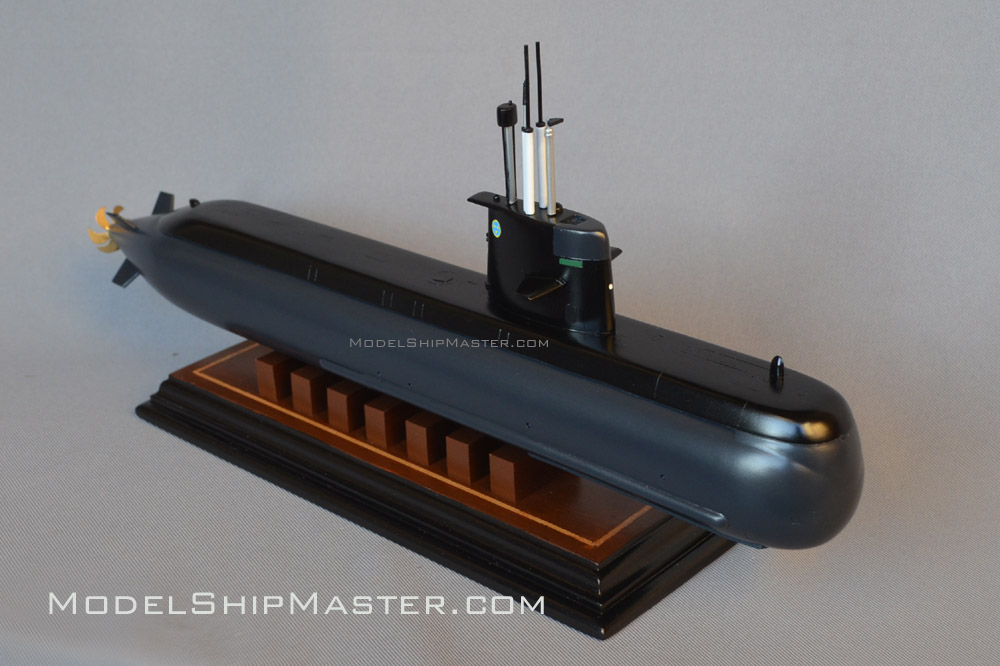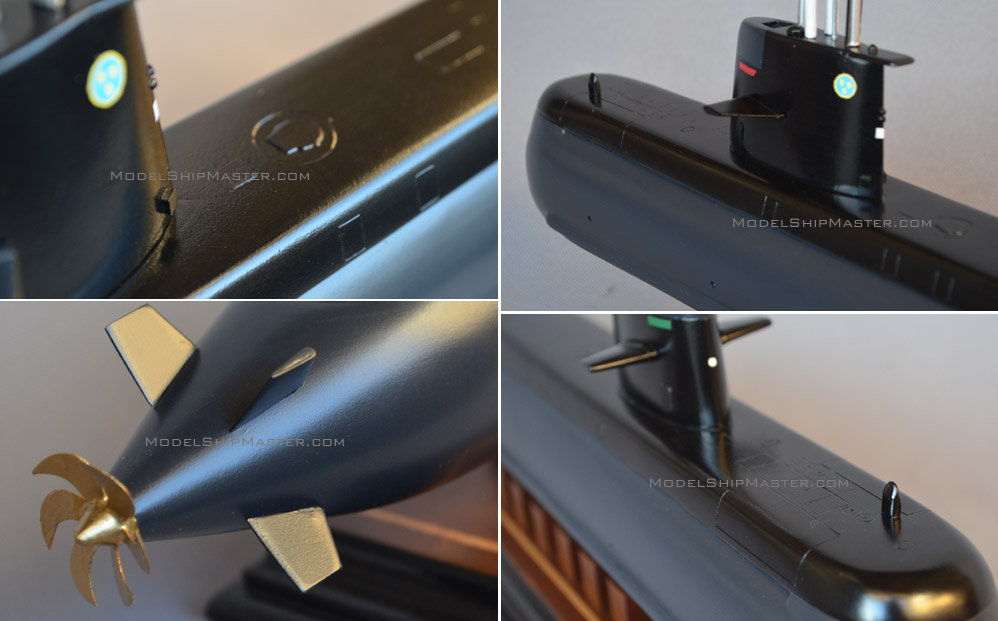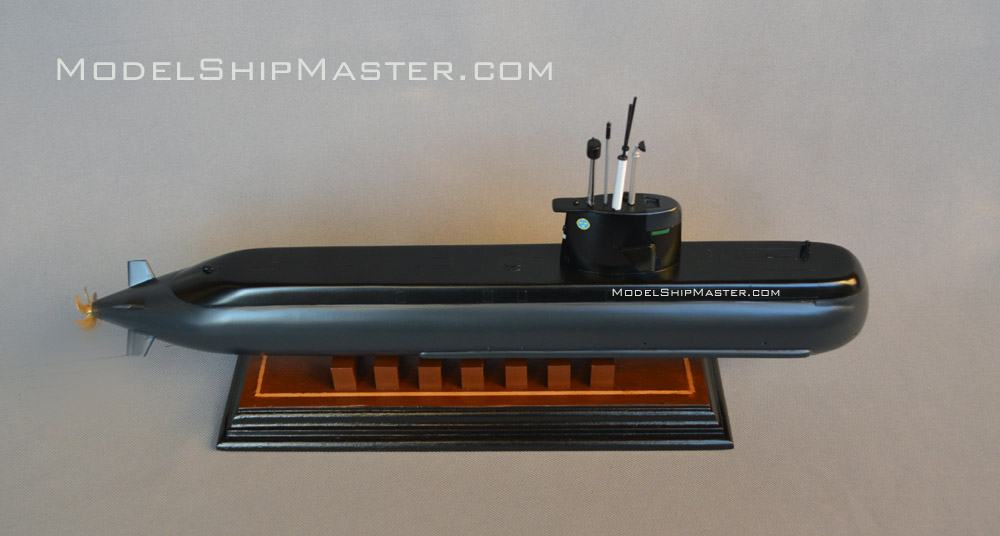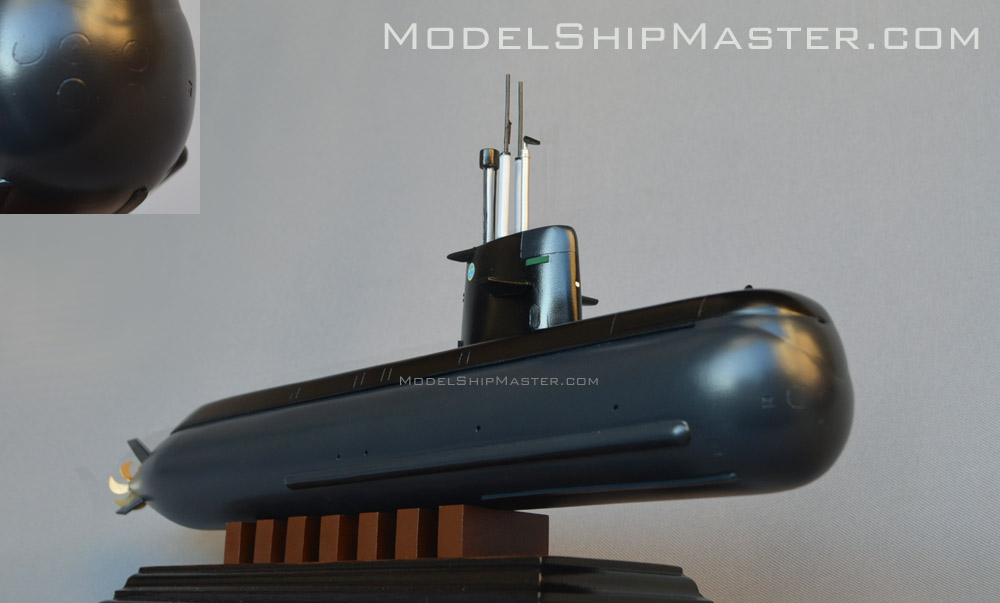|
GOTLAND SUBMARINE MODEL
Gotland submarine is a
small Swedish diesel-powered submarine. In 2005,
USS Ronald Reagan aircraft carrier sank after being
hit by multiple torpedoes during a war
game pitting a carrier task force including numerous
antisubmarine escorts against Gotland. Despite making multiple attacks on the Reagan,
the Gotland submarine was never detected.

The story
began on September 16, 2000 when HSwMS Halland took part
in a multi-national exercise in the Mediterranean. There
she remained undetected while still recording many of
her friendly adversaries, attracting interest from the
participating countries. In early November the same
year, she participated in a NATO "blue-water" exercise
in the Atlantic. There, she won a victory in a mock
"duel" with Spanish naval units, and then the same in
similar duel against a French nuclear-powered
attack submarine. She also "defeated" an American
the USS Houston submarine.

Soon, the Swedish government received a request from the
United States to lease the Gotland submarine– Swedish
commanded and manned, for a duration of one year for use
in antisubmarine warfare exercises. The Swedish
government granted this request. The lease was extended
for another 12 months.
HSwMS
Gotland managed to snap several pictures of USS Ronald
Reagan during a wargaming exercise in the Pacific Ocean,
effectively "sinking" the aircraft carrier. The exercise
was conducted to evaluate the effectiveness of the US
fleet against diesel-electric submarines.
How was
the Gotland submarine able to evade the USS Reagan’s elaborate
antisubmarine defenses involving multiple ships and
aircraft employing a multitude of sensors?
Diesel submarines in the past were limited by the
need to operate noisy, air-consuming engines that
meant they could remain underwater for only a few
days before needing to surface. Naturally, a
submarine is most vulnerable, and can be most easily
tracked, when surfaced, even when using a snorkel.

However, the two-hundred-foot-long Swedish
Gotland submarine, introduced in 1996, were
the first to employ an Air Independent Propulsion (AIP)
system. A Stirling
engine charges the submarine’s seventy-five-kilowatt
battery using liquid oxygen.
With the Stirling, a Gotland submarine can
remain undersea for up to two weeks sustaining an
average speed of six miles per hour—or it can expend
its battery power to surge up to twenty-three miles
per hour. A conventional diesel engine is used for
operation on the surface or while employing the
snorkel. The Stirling-powered Gotland runs more
quietly than even a nuclear-powered submarine.
The Gotland submarine possess many other
features that make it adept at evading detection. It
mounts twenty-seven electromagnets designed to
counteract its magnetic signature to Magnetic
Anomaly Detectors. Its hull benefits from
sonar-resistant coatings, while the tower is made of
radar-absorbent materials. Machinery on the interior
is coated with rubber acoustic-deadening buffers to
minimize detectability by sonar. The Gotland
submarine is also
exceedingly maneuverable thanks to the combined six
maneuvering surfaces on its X-shaped rudder and
sail, allowing it to operate close to the sea floor
and pull off tight turns.
Because the stealthy submarine proved the ultimate
challenge to U.S. antisubmarine ships in
international exercises, the U.S. Navy leased
the Gotland and its crew for two entire years to
conduct antisubmarine exercises. The results
convinced the U.S. Navy its undersea sensors simply
were not up to dealing with the stealthy AIP boats.

This primarily wood Gotland submarine model is
17"
x 9" x 4" (1/100)
$1,219  Shipping and insurance in
the contiguous USA included.
Other places: $200 flat rate.
This model is in stock and can be shipped within
five business days. Shipping and insurance in
the contiguous USA included.
Other places: $200 flat rate.
This model is in stock and can be shipped within
five business days.
For different sizes,
contact us for a quote:
Services@ModelShipMaster.com.
For another submarine
that sank an aircraft carrier in a military
exercise:
Le Saphir.
Learn
more about the Gotland submarine here:
https://nationalinterest.org/blog/the-buzz/swedens-super-stealth-submarines-are-so-lethal-they-sank-us-18383
https://en.wikipedia.org/wiki/Gotland-class_submarine
|